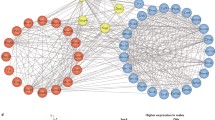
Overview
- Sets new perspectives for understanding biological sex
- Presents the latest findings in sex determination and sexual differentiation, and sex maintenance
- Provides examples of sex spectrums in different organisms
Buy print copy
About this book
This book introduces cutting-edge studies on the spectrum of sex. The sex spectrum can be understood as an interwoven mechanism sustaining graded phenotypes between the two sexes.
The book overviews three elements that develop the sex spectrum: genetics, the endocrine system, and the environment. Part I discusses the genetic regulation during sex determination, which often results in a mixture of two sexes or sex reversal. The evolutionary aspects of the genetic determinants are also discussed. Part II presents the involvement of endocrine regulation in the sex spectrum, which covers a broad range of phenotypic events, including sexual behavior and metabolism. Interestingly, sex hormones can also act as sex determinants. Finally, Part III shows that intrinsic factors, such as sex-determining genes and sex hormones, are not the only factors in sex development. The environment surrounding organisms, such as symbiosis and metabolism, act on the sex as critical factors, generating the sex spectrum.
Determination and development of the two sexes have been a topic of great interest and a long-standing issue in biology. The book updates the conventional view that biological sex is fixed after birth and sets new perspectives for understanding sex as a spectrum manifested in multiple phenomena. Each chapter contributed by leading experts explains the sex spectrum in various organisms and their underlying mechanisms from the latest ongoing studies. The book provides a valuable resource for not only experts in developmental biology, physiology, and medical science, but also non-scientists and anyone interested in the topic.
Similar content being viewed by others
Keywords
Table of contents (13 chapters)
-
Front Matter
-
Genetic Regulation of the Sex Spectrum
-
Front Matter
-
-
Endocrine Regulation of the Sex Spectrum
-
Front Matter
-
-
Environmental Regulation of the Sex Spectrum
-
Front Matter
-
Editors and Affiliations
About the editors
Bibliographic Information
Book Title: Spectrum of Sex
Book Subtitle: The Molecular Bases that Induce Various Sexual Phenotypes
Editors: Minoru Tanaka, Makoto Tachibana
DOI: https://doi.org/10.1007/978-981-19-5359-0
Publisher: Springer Singapore
eBook Packages: Biomedical and Life Sciences, Biomedical and Life Sciences (R0)
Copyright Information: The Editor(s) (if applicable) and The Author(s), under exclusive license to Springer Nature Singapore Pte Ltd. 2022
Hardcover ISBN: 978-981-19-5358-3Published: 09 November 2022
Softcover ISBN: 978-981-19-5361-3Published: 10 November 2023
eBook ISBN: 978-981-19-5359-0Published: 07 November 2022
Edition Number: 1
Number of Pages: VIII, 233
Number of Illustrations: 1 b/w illustrations
Topics: Biochemistry, general, Cell Biology, Gender Studies, Evolutionary Biology, Developmental Biology, Zoology



